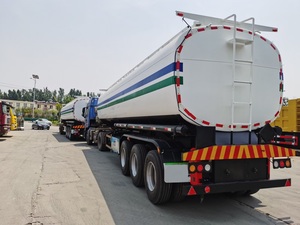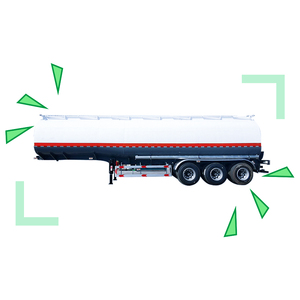(451 products available)




































































































































































































































A fuel tanker is a large commercial vehicle and is primarily used to transport fuel. The 60CBM fuel tanker truck has a capacity of 60,000 liters. Fuel tankers are available in different types, depending on the design and the type of fuel being transported. Below are the different types of 60CBM fuel tanker trucks.
Gasoline Tanker
These types of fuel tankers are designed to transport gasoline. They have special features such as anti-static systems and temperature control systems. The primary role of the anti-static system is to prevent static electricity that can cause explosions.
Diesel Tanker
These tankers are primarily used to transport diesel fuel. Diesel tankers have similar designs and features as gasoline tankers. They are equipped with safety features like anti-static systems and spill prevention systems.
Chemical Tankers
Chemical tankers are designed to transport chemicals in liquid form. They are constructed using corrosion-resistant materials. Chemical tankers also have several safety features such as fire protection systems and emergency response equipment.
Jet Fuel Tanker
These types of fuel tankers are designed to transport jet fuel. Jet fuel tankers have safety and quality control measures. For example, they have temperature control systems to maintain the required temperature during transportation. They also have cleanliness controls to ensure the transported fuel meets the required cleanliness standards.
Propane Tanker
These types of fuel tankers are designed to transport liquid petroleum gas (LPG). Propane tankers are equipped with safety features such as pressure relief systems and leak detection systems. They also have specialized loading and unloading equipment due to the unique properties of propane.
Biodiesel Tanker
Biodiesel tankers are designed to transport biodiesel. They have features that ensure the transported biodiesel meets the required quality standards, such as temperature monitoring systems and contamination prevention measures.
Ethyl Alcohol Tanker
These tankers are designed to transport ethanol. Ethanol tankers have safety features such as fire prevention systems and emergency response equipment due to the flammable nature of ethanol.
These are some specifications of a 60 m³ fuel tanker.
Theoretical capacity
Theoretical capacity refers to the total volume of the fuel that can be filled in the tank. For a 60 m³ fuel tanker, the theoretical capacity is 60 m³ or 60,000 liters. In practice, the effective capacity is usually lower than the theoretical capacity. This is because the fuel tanks' shape and design are not suitable for completely filling the fuel.
Dimensions
The dimensions of a 60 m³ fuel tanker vary depending on the design and type of tanker. Generally, the length is about 12 to 15 meters. The width is about 2.5 to 3 meters, and the height is about 3.5 to 4 meters.
Tare weight
Tare weight is the weight of the fuel tanker without any fuel inside. For a 60 m³ fuel tanker, the tare weight is about 20,000 to 30,000 kg, depending on the materials used for construction.
Maximum loading capacity
Maximum loading capacity refers to the maximum weight that can be loaded onto the fuel tanker, including the fuel and the tanker itself. For a 60 m³ fuel tanker, the maximum loading capacity is about 70,000 to 80,000 kg. This means that the fuel tanker can carry about 50,000 to 60,000 liters of fuel, depending on the type of fuel and its density.
Number of compartments
A 60 m³ fuel tanker can have one or more fuel compartments. If there are multiple compartments, the number of compartments can range from 2 to 6, and each compartment can hold about 10,000 to 12,000 liters of fuel. The compartments are separated by vertical walls inside the fuel tank.
Pump capacity
The pump capacity of a 60 m³ fuel tanker is about 30 to 40 m³/h. This means that the fuel can be loaded or unloaded at a rate of 30,000 to 40,000 liters per hour. The pumps in the fuel tankers are usually electric or hydraulic pumps.
Loading and unloading
Fuel loading and unloading operations are essential for fuel supply chain logistics. For fuel loading, the loading port is usually located at the top of the fuel tanker. Fuel flows through pipes from fuel supply stations or fuel depots into the fuel compartments. Fuel unloading occurs at fuel distribution stations or gas stations. Fuel flows out of the compartments through pumps and pipelines.
Safety devices
A 60 m³ fuel tanker is equipped with various safety devices to prevent accidents and ensure safe transportation of flammable liquids. These devices include pressure relief valves, level indicators, and emergency shutdown systems.
Material
60cbm fuel tankers are generally made from steel or aluminum alloys. The choice of material affects the fuel tankers' strength, durability, and corrosion resistance. Steel is more commonly used due to its good mechanical properties and relatively low cost.
Tar and sludge accumulation
Tar and sludge buildup in fuel tanks can adversely affect the quality and performance of the stored fuel. To avoid this, the fuel tanker should be regularly inspected and cleaned to remove any tar and sludge deposits. Additionally, using fuel additives can help prevent the formation of tar and sludge in the fuel. These additives work by inhibiting the polymerization and aggregation of impurities in the fuel, thus keeping it clean and stable.
Corrosion
Corrosion can weaken the structural integrity of the fuel tanker over time. Environmental factors like moisture, high humidity, and exposure to corrosive substances can cause corrosion. To prevent this, appropriate corrosion protection measures should be taken. These measures may include using corrosion inhibitors, applying protective coatings, and regularly inspecting and maintaining the condition of the fuel tanker.
Overfilling and spillage
Overfilling and spillage during fuel loading operations can pose safety and environmental risks. To mitigate these risks, appropriate measures should be taken. For instance, using automatic shut-off devices can prevent overfilling by stopping the fuel flow when the predetermined level is reached. Additionally, spill containment systems can minimize the impact of spillage by containing and collecting the spilled fuel, thereby reducing environmental contamination and fire hazards.
Purpose of the Tanker:
Consider what the tanker will be used for. Will it be transporting gasoline, diesel, or another type of fuel? Different fuels have different regulations and safety considerations.
Regulatory Compliance:
Make sure the tanker meets all local and national regulations for transporting fuel. This can include things like emission standards, safety equipment requirements, and tank design standards.
Safety Features:
Look for tankers with good safety features. This can include things like rollover protection, crash protection, and safe loading and unloading systems. Also consider what safety features will be needed for the specific type of fuel being transported.
Maintenance and Reliability:
Consider the expected maintenance needs and reliability of the tanker. A more reliable tanker will require less maintenance and fewer breakdowns, saving money in the long run. Compare the maintenance requirements and expected reliability of different tankers.
Cost:
Of course, cost is an important consideration when choosing a fuel tanker truck. But also think about the long-term value. A more expensive tanker may have lower maintenance costs or higher fuel efficiency, for example.
Environmental Considerations:
Consider the environmental impact of the tanker. Tankers with lower emissions or that are designed to minimize spills can be better for the environment.
It is important to note that fuel tankers are complex and dangerous to handle. Therefore, when attempting to DIY, ensure that the user's safety and the environmental safety aspect are upheld. If not, it is advisable to seek professional help. That said, here are some general steps that might be involved in repairing or working on a 60-cbm fuel tanker:
Q1: How many liters are there in a 60-cubic fuel tanker?
A1: A fuel tanker with a capacity of 60 cubic meters can hold 60,000 liters of fuel.
Q2: What is the dimension of a 60cbm fuel tanker?
A2: The dimensions of a 60-cbm fuel tanker may vary depending on the design and manufacturer. Typically, the length is about 12.5 meters, the width 2.5 meters, and the height 3.8 meters.
Q3: How many compartments does a 60cbm fuel tanker have?
A3: A 60-cbm fuel tanker can have 1 to 4 compartments. The number of compartments depends on the customer's requirements and the tanker's design.